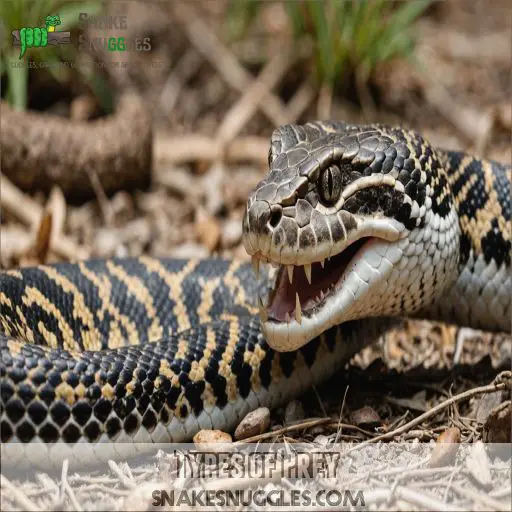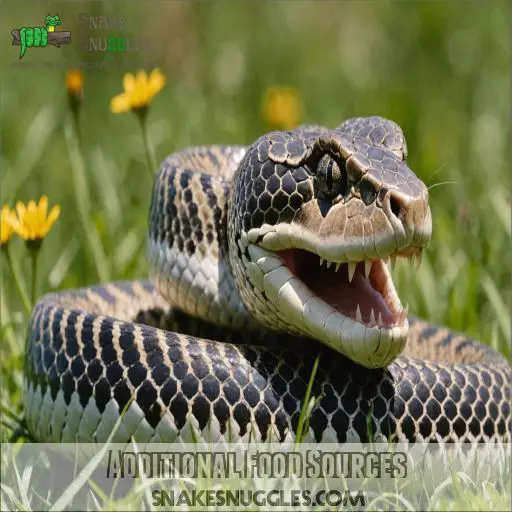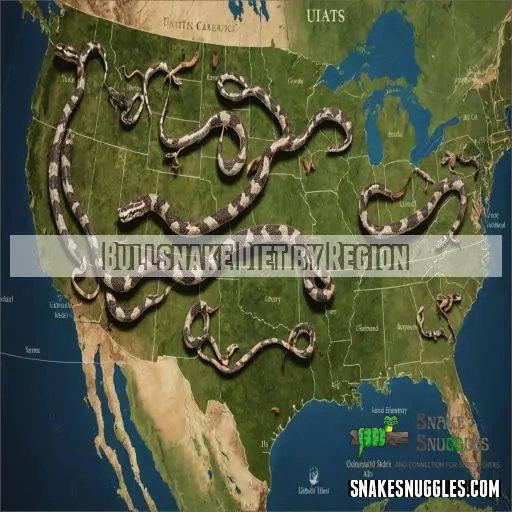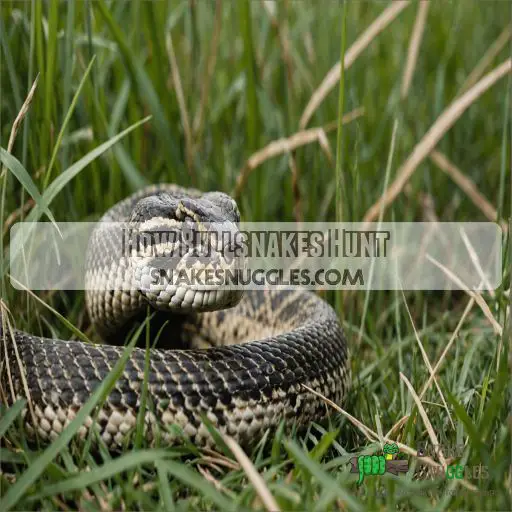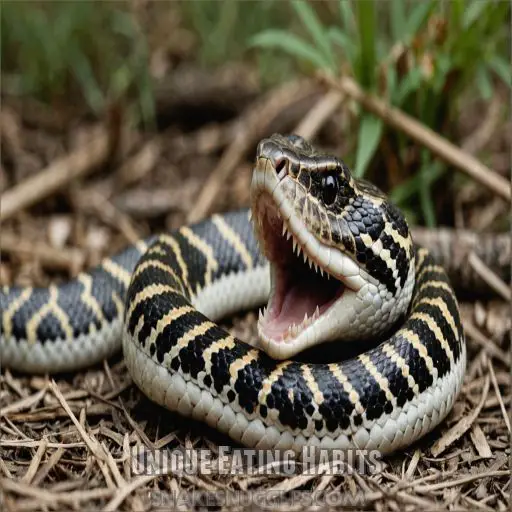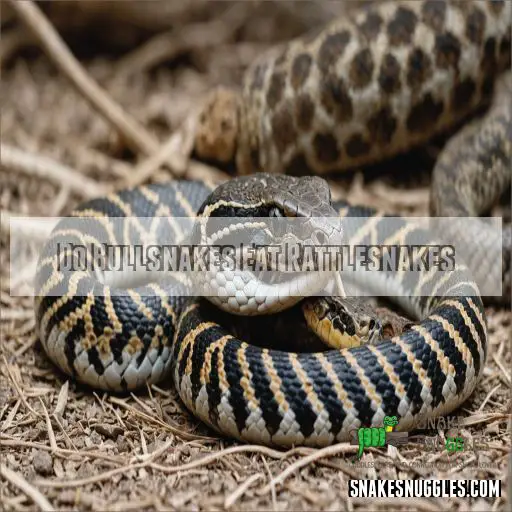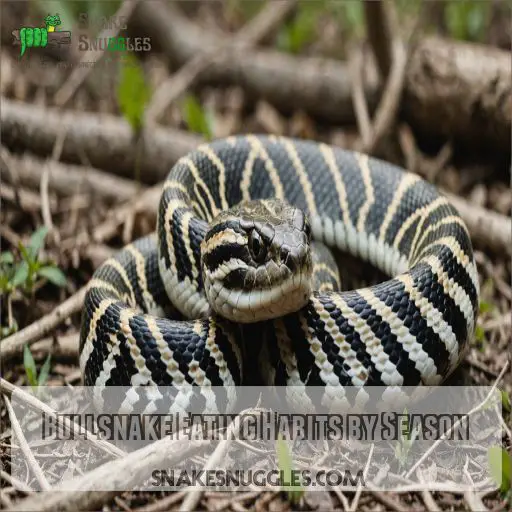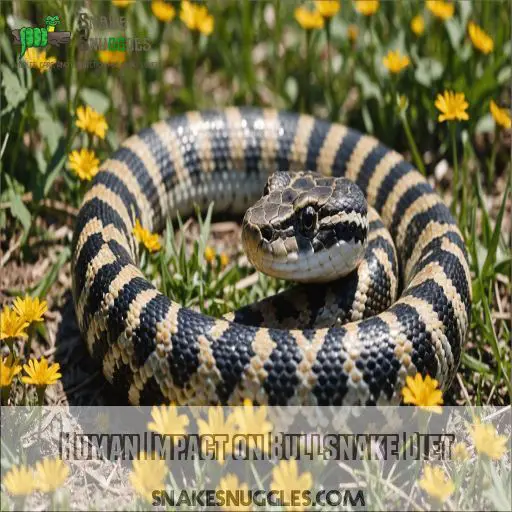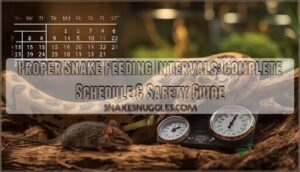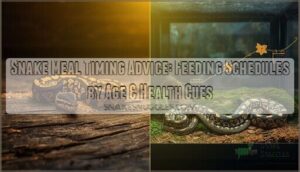This site is supported by our readers. We may earn a commission, at no cost to you, if you purchase through links.
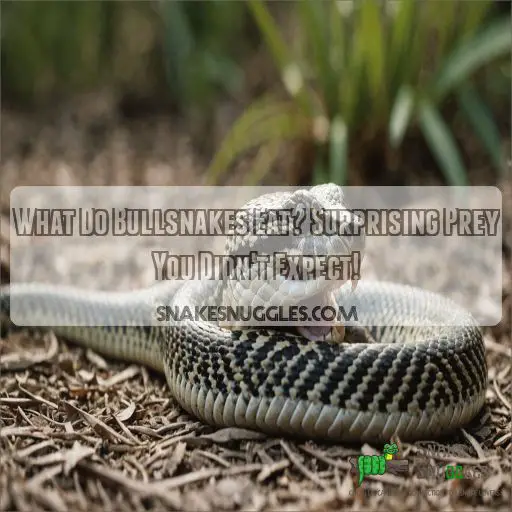 You’ll be surprised by the diverse menu of bullsnakes! These beneficial reptiles primarily feast on small mammals like gophers, mice, voles, and squirrels.
You’ll be surprised by the diverse menu of bullsnakes! These beneficial reptiles primarily feast on small mammals like gophers, mice, voles, and squirrels.
But they also enjoy a tasty bird egg or two, especially from ground-nesting species like quail and meadowlarks.
What’s interesting is that bullsnake diets can vary by region – eastern bullsnakes tend to favor voles and squirrels, while their western counterparts may include jackrabbits.
And they’re quite the opportunists, adjusting their meals with the seasons.
So next time you spot a bullsnake, remember it’s doing important work controlling rodent populations and maintaining a healthy ecosystem. Curious to learn more about their unique hunting tactics and eating habits like the snake and mouse struggle?? Keep reading!
Table Of Contents
- Key Takeaways
- What Do Bullsnakes Eat
- Types of Prey
- Additional Food Sources
- Bullsnake Diet by Region
- How Bullsnakes Hunt
- Unique Eating Habits
- Do Bullsnakes Eat Rattlesnakes
- Bullsnake Eating Habits by Season
- Human Impact on Bullsnake Diet
- Importance of Bullsnakes in the Ecosystem
- Frequently Asked Questions (FAQs)
- Are bull snakes good to have around?
- Will a bull snake bite me?
- Where do bull snakes nest?
- What to do if you find a bull snake?
- How often do bull snakes need to eat?
- Do bull snakes eat insects or spiders?
- Are bull snakes interested in carrion?
- What size prey do bull snakes prefer?
- How do bull snakes catch fast-moving prey?
- Conclusion
Key Takeaways
- Bullsnakes are nature’s pest control experts, feasting on small mammals like gophers, mice, voles, and squirrels to maintain a balanced ecosystem. You’ll be amazed by their diverse dining habits.
- While bullsnakes primarily target rodents, they’ll also snack on bird eggs, especially from ground-nesting species. Their menu varies by region, with eastern bullsnakes favoring voles and squirrels, while western ones may include jackrabbits.
- Bullsnakes are skilled hunters, using stealth and powerful constriction techniques to capture their prey. They swallow their meals whole without chewing, relying on strong stomach acids for digestion.
- Having bullsnakes around is a good thing. These nonvenomous snakes play a crucial role in controlling rodent populations, protecting crops, and maintaining the natural balance of ecosystems. So next time you spot one, give a round of applause for nature’s original pest control service.
What Do Bullsnakes Eat
Bullsnakes have a penchant for snacking on small mammals, making your backyard enemy their favorite meal.
They’ve got a reputation for being nature’s rodent control team, munching on everything from sneaky mice to those annoying garden gophers.
Main Food Sources
Ever wondered what a bullsnake munches on?
Their main food sources include small mammals, but sometimes they’ll snack on birds and eggs too.
These reptiles help control rodent populations, balancing the ecosystem while enjoying nature’s original fast food menu.
Small Mammals as Prey
Bullsnakes’ voracious appetite for small mammals like gophers, mice, voles, and squirrels makes them skilled predators, helping maintain a balanced ecosystem by controlling rodent populations.
- Gophers
- Mice
- Voles
- Squirrels
Types of Small Mammals
When you start looking at bullsnake prey preferences, you’ll spot a smorgasbord of small mammals like mice, gophers, voles, and even squirrels.
These adaptable reptiles enjoy diverse habitats where prey availability flourishes, highlighting the importance of balanced wildlife management.
Role in Controlling Rodent Populations
Bullsnakes pack a punch for rodent control.
They help maintain ecosystem balance by regulating rodent populations, benefiting agricultural areas.
So, while they might seem intimidating, their impact on controlling pests is a farmer’s best friend!
Types of Prey
Imagine you’ve discovered a bullsnake’s menu, and it’s not your average dining list.
While these snakes have a taste for chewy gophers, plus some small and crunchy mice, voles, and squirrels, they’re nature’s very own pest control service, tackling the rodent population with ease.
Gophers
Bullsnakes are masters at hunting gophers, their primary prey.
These burrowing rodents are no match for the snake’s keen senses and powerful constriction.
Gopher burrows provide shelter, food, and a prime hunting ground for bullsnakes.
Mice
Within their diet, mice play a starring role for bullsnakes.
Mice are like a five-star meal for these snakes, offering both nutrition and satisfaction.
They’re essential to bullsnake survival, controlling rodents with finesse and maintaining ecological balance.
Voles
Ever find yourself asking, "What do bull snakes eat?"
Well, alongside mice, they gobble up voles too!
These tiny critters are a favorite snack, given their active digging in vole habitats.
They’re a staple in the bullsnake’s diet.
Squirrels
Now, let’s scamper onto squirrels as prey. Longtime backyard acrobats dual as bullsnake snacks. You might see:
- Tree-dwellers
- Ground-nesters
- Nut-hoarders
Their high-squirrel antics can’t always evade the stealthy slither of a bullsnake. They’re surprise meals in nature’s buffet!
Additional Food Sources
You might be surprised to learn that bullsnakes aren’t picky eaters.
They also munch on birds and their eggs.
These snake sous-chefs favor ground-nesting birds, offering you a glimpse into their ever-adaptable dining habits.
Birds and Their Eggs
Bullsnakes don’t just stop at furry creatures; they’ve also got a taste for birds and their eggs.
While strolling through habitats, you might spot one investigating nests.
Egg predation is part of their diet, showcasing fascinating bullsnake-bird interactions and the unique balance in nature’s grand buffet.
Ground-Nesting Birds
Bullsnakes also prey on ground-nesting birds, snatching up their eggs and hatchlings.
These birds, like quail, pheasants, and meadowlarks, make their homes right on the ground – an easy target for the bullsnake’s keen senses.
Protecting their nests is a constant challenge.
Types of Birds as Prey
You might not expect it, but some bird species make it onto a bullsnake’s menu.
These snakes easily navigate nesting habits, using clever hunting strategies to catch prey like ambush predators.
Prey size varies regionally, but some birds are always on the lookout for slithering guests.
| Bird Type | Nesting Habitat | Prey Size |
|---|---|---|
| Sparrows | Open fields | Small |
| Quail | Grasslands | Medium |
| Wrens | Forest edges | Tiny |
| Finches | Shrubby areas | Very small |
| Pheasants | Dense thickets | Moderate |
Bullsnake Diet by Region
You’ll find that bullsnakes’ dining preferences vary across regions, kind of like how humans have different tastes depending on their location.
Eastern bullsnakes might prefer one menu, while their western cousins have a different palate, adapting to the local cuisine with skill and flair.
Variations in Food Sources by Location
Regional differences spice up a bullsnake’s diet, adapting their food choices based on habitat, climate, and prey availability.
So grab a map and join in their culinary journey across the land:
- Grassland gophers
- Woodland mice
- Desert voles
Eastern Bullsnakes’ Diet
In the eastern U.S., these clever snakes feast on a smorgasbord of small rodents, from nimble voles to bushy-tailed squirrels, helping maintain a balanced ecosystem.
Their adaptable diet helps them survive.
Western Bullsnakes’ Diet
Now, heading west, bullsnake dining habits stay intriguing.
California’s diverse habitat enriches their menu with local delights.
Western bullsnake prey includes rodents aplenty, delighting exterminators.
Seasonal variations flavor their diet, underscoring their significant role in natural rodent control.
Adaptations in Food Sources
While chowing down on jackrabbits in the west, you’d be surprised to know bullsnakes in other regions switch prey.
They tackle regional diet adaptation through habitat-specific hunting, finding food scarcity solutions, and embracing seasonal diet changes seamlessly.
How Bullsnakes Hunt
You wouldn’t want to be a small mammal around a hunting bullsnake!
With its precise stalking and expert constricting techniques, this snake has got a foolproof method for catching a meal.
Stalking Prey
Exploring bullsnakes’ regional diet shows how they rely on keen prey detection. These snakes expertly stalk their prey, using clever ambush strategies. Imagine spotting a mouse and striking with precision! It’s like a stealthy ninja ready to pounce!
- Hunting methods are intricate
- Strike precision is admirable
- Their stealth approach fascinates
Constricting Techniques
As bullsnakes prepare to constrict their prey, they adopt coiling patterns with precision, employing a constriction force that renders prey immobile.
This asphyxiation process is the feeding mechanism they rely on, blending efficiency with a touch of snake charm.
Eating Habits
Consequently, bullsnake feeding patterns reveal interesting eating habits, much like the diverse foraging strategies of Black Rat Snakes.
They often engulf prey whole without chewing.
Here’s how:
- Use stealth to approach.
- Constrict using powerful muscles.
- Swallow prey head-first.
- Rely on strong stomach acids for digestion.
Specialized Physical Features
Moving from eating habits to specialized features, bullsnakes boast unique head scale patterns, enhancing their excavation ability.
Their pointed tail structure aids in digging, while distinct eye characteristics provide sharp vision.
Their striking body coloration camouflages them perfectly as they hunt.
Unique Eating Habits
When you think about how bullsnakes eat, picture them at an all-you-can-eat buffet, swallowing their prey whole without chewing.
Just don’t expect any teeth or venom at this dinner party—these snakes prefer their meals served as is, with digestion doing all the hard work.
Swallowing Prey Whole
Unhinging their jaws like they’re auditioning for a monster movie, bullsnakes have developed impressive swallowing techniques.
This adaptation allows them to tackle larger prey sizes with ease.
As digestion kicks in, the nutritional benefits are revealed, ensuring these slithery connoisseurs remain comfortably sated and ready for their next meal, thanks to their ability to tackle larger prey sizes.
No Venom or Teeth
Without venom or teeth, bullsnakes rely on constriction efficiency to capture prey.
Their toothless consumption is an advantage, as they don’t need to chew—just swallow whole.
This behavior is linked to their defensive behaviors, making them a fascinating example of nature’s unique digestive adaptations.
Digestion Process
Now that you know bullsnakes have no venom or teeth, let’s tackle their digestion process.
Bullsnakes are like master chefs, breaking down meals through:
- Enzymatic breakdown.
- Nutrient absorption.
- Digestive efficiency.
- A quirky metabolic rate that makes the gut microbiome a busy place!
Do Bullsnakes Eat Rattlesnakes
You might be surprised to hear that bullsnakes don’t typically feast on rattlesnakes, but let’s clear up that myth.
While they’ve been known to occasionally snack on a small rattlesnake, they’re not exactly chasing them down.
Debunking Common Myths
Let’s explore some slippery myths! Contrary to popular belief, bullsnakes don’t slurp down rattlesnakes like spaghetti.
They don’t breed with rattlesnakes either, given their differing reproductive methods.
So, if you’re picturing a showdown, relax, bullsnakes prefer gophers over drama in their sandy habitats.
Rattlesnakes as Prey
When exploring rattlesnake myths, do bullsnakes really target rattlesnakes as prey? It turns out, they don’t actively hunt them.
This snake feud remains largely fictional, with bullsnakes focusing on their favorite warm-blooded meals instead.
- Bullsnakes prefer small mammals
- Rarely encounter rattlesnakes
- Coexist peacefully
Limited Evidence of Rattlesnake Consumption
While folks often chat about bullsnake-rattlesnake interactions, there’s scant evidence they munch on rattlesnakes regularly.
In a study, only two out of 1000 bullsnakes had rattlesnake remains. They prefer easier meals. It’s like choosing fast food over a five-course meal!
| Rattlesnake Digestion | Physical Features | Preying Behaviors |
|---|---|---|
| Bullsnake Rare Digests | No Rattles | Opportunistic |
| Efficient Moving | Gentle Bite | Warm-blooded Prey |
| Natural Avoidance | Constriction | Rodent Focus |
Bullsnake Eating Habits by Season
Just like you might crave ice cream in the summer and hot chocolate in the winter, bullsnakes adjust their menu with the season’s bounty.
In the warm months, they’re feasting on rodents and bird eggs,
while winter makes their hunts more opportunistic and sparse, making them more opportunistic.
Seasonal Variations in Diet
Bullsnakes’ appetites dance with the seasons like kids at a festival.
During spring’s breeding season, they feast more, prioritizing energy for romance.
When winter’s chill prompts hibernation, they shelve dining plans, awaiting balmier days.
Seasonal shifts in prey availability challenge them, sparking fascinating changes in foraging behavior.
Food Sources During Summer
Summer’s bounty turns bullsnakes into expert diners, with food so abundant you’d think they’re at an all-you-can-eat buffet.
Their summer prey includes gophers, mice, and birds.
The heat impacts their seasonal diet by making these food sources more accessible during their daytime foraging adventures.
Food Sources During Winter
In winter, bullsnakes tackle food scarcity with savvy survival strategies.
Although hibernation is common, they may still hunt:
- Small rodents seeking warmth
- Birds perched nearby
- Insects hiding under leaves
- Frogs beneath frozen ground
- Rarely, unfortunate lizards
Winter’s chill doesn’t always buffet their dining plans!
Human Impact on Bullsnake Diet
Unfortunately, human activities like habitat destruction and disturbance can have a big impact on bullsnake populations and their food sources.
Conservation efforts are underway to protect these essential predators and maintain the balance of their ecosystems.
Habitat Destruction and Food Sources
As the seasons change, so do the bullsnakes’ dietary options.
Sadly, as habitats shrink due to development, finding food becomes tougher.
This loss of habitat directly impacts the bullsnake diet, limiting their ability to hunt and control rodent populations.
Conservation strategies help protect and adapt their food sources.
Human Disturbance and Bullsnake Behavior
When you picture bullsnakes slithering through their habitats, remember that habitat loss and road mortality put them on thin ice.
Human interactions can stress these snakes out, altering behavior and diet.
They’d rather munch on their usual prey instead of dodging tires and people!
Conservation Efforts to Protect Bullsnakes
Habitat loss knocks bullsnakes out of their homes faster than a greased pig at a county fair!
To protect them, focus on:
- Reintroduction programs in suitable areas.
- Reducing road mortality with crossings.
- Engaging in public education.
- Promoting snake identification skills.
Let’s keep these slithery pals safe!
Importance of Bullsnakes in the Ecosystem
You might be surprised to learn just how important bullsnakes are to maintaining a healthy ecosystem.
As skilled predators of small rodents, these snakes play a significant role in controlling pesky populations and keeping the natural balance in check.
Controlling Rodent Populations
Picture bullsnakes as the unsung heroes of rodent control!
By munching on pesky gophers, mice, and squirrels, they help maintain a balanced ecosystem.
Their presence means fewer little critters eating crops or invading homes.
It’s nature’s original pest control, saving you stress—and possibly a panic attack!
Maintaining Balance in the Ecosystem
Bullsnakes are unsung heroes of the ecosystem.
By controlling rodent populations, they:
- Reduce damage to crops.
- Minimize disease spread by rodents.
- Maintain soil health through balanced predation.
- Support biodiversity.
Despite habitat loss, these resilient critters provide important ecosystem services.
They’re snake-tastic natural pest controllers!
Role in the Food Chain
Ever heard of a snake being a fantastic exterminator?
Bullsnakes play a key role in the food chain by controlling rodent populations.
They keep ecosystems balanced, reducing snake competition and ensuring prey availability.
Next time you see one, give thanks for their pest control services!
Frequently Asked Questions (FAQs)
Are bull snakes good to have around?
While some might worry about snake bites, bull snakes are actually beneficial.
They control rodent populations by feasting on gophers, mice, and more.
Having them around is like having a natural pest control service!
Will a bull snake bite me?
You’re unlikely to be bitten by a bullsnake unless it feels threatened.
These snakes are nonvenomous and prefer avoiding humans, but a startled snake might bite defensively.
So, tread lightly and give them space to slither away.
Where do bull snakes nest?
Ah, so you’re curious about where these slithery critters make their nests, eh?
Well, let me tell you – bullsnakes are quite the resourceful bunch.
They love to burrow right into those cozy rodent dens, making themselves right at home.
Just don’t go sticking your hand in there uninvited!
What to do if you find a bull snake?
Spotting a bullsnake is like finding nature’s pest control expert.
Give it space to move away calmly.
Don’t worry; they’re nonvenomous and shy.
Relish the moment of encountering a valuable part of the ecosystem!
How often do bull snakes need to eat?
Bull snakes, with their ravenous appetites, need feeding every 7 to 10 days as adults.
They need feeding every 5 to 7 days while they’re young.
Do bull snakes eat insects or spiders?
You might think bull snakes munch on insects or spiders, but they don’t.
They prefer their meals to be a bit larger, like rodents or birds.
So, insects aren’t really on their dinner menu (Source).
Are bull snakes interested in carrion?
Bullsnakes aren’t particularly interested in carrion, as they primarily hunt live prey like small mammals, birds, and rodents. (Source)
Their diet focuses on capturing and consuming active, warm-blooded animals rather than scavenging on dead carcasses.
What size prey do bull snakes prefer?
Imagine a bullsnake eyeing a plump vole like you’ve just discovered a hidden chocolate stash.
These snakes mainly target small to medium-sized prey like rodents and birds, ensuring they can swallow whole without choking hazards.
How do bull snakes catch fast-moving prey?
Catch fast-moving prey? Give them credit!
With stealth as their trusty sidekick, they rely on expert vibration detection and a quick constriction move.
Sneaking up, they strike swiftly, wrapping and squeezing until their meal can’t escape (Source).
Conclusion
Imagine bullsnakes as nature’s unsung pest control officers, clocking in without a badge or uniform.
If you’re wondering, "What do bull snakes eat?"—besides the usual rodents, their menu includes eggs and even the occasional jackrabbit.
They adapt to changing seasons and regional differences, maintaining a balanced ecosystem.
Without bullsnakes, you’d have more rodents messing up your garden.
By dispelling myths and understanding their important role, you can appreciate these remarkable creatures a bit more.


